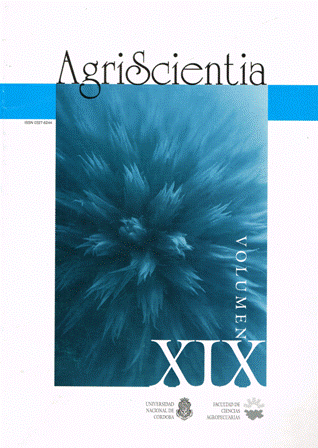Selection responses for some agronomic traits in hexaploid triticale
Main Article Content
Abstract
The aims of this study were to estimate the direct response to selection for grain number per spikelet and meiotic index and to evaluate the correlated responses for several agronomic traits. The selection and evaluation processes were performed at Campo Escuela de la Facultad de Ciencias Agropecuarias (Universidad Nacional de Córdoba), Córdoba, Argentina. The F2:3, F2:4 and F2:5 families were evaluated respectively during 1997, 1998 and 1999. The triennial analysis showed significant differences between the mean values of the families corresponding to the divergent groups derived from plants selected and evaluated according to high and low number of grains per spikelet and high and low percentage of normal tetrads criteria. With respect to other traits, significant statistical differences between group mean values of the selected material for high and low grain number per spikelet were observed for grain yield per plot and per spike, some physical grain yield components such as grain number per spike, grain number per square metre,and one physiological component such as harvest index. In conclusion, the grain number per spikelet has two essential requirements from a plant breeder's point of view, viz. it has genetic variability and presents correlated responses in relation tothe grain yield.
Article Details
Issue
Section

This work is licensed under a Creative Commons Attribution-ShareAlike 4.0 International License.
How to Cite
References
Dubovets, N. I., G. V. Dymkova, L. A. Solovej, T. I. Shtyk and V. E. Bormotov. 2002. A study on spring hexaploid triticales with mixed wheat karyotypes. In: Proc. of the 5th International Triticale Symposium, Radzików, Poland. pp. 33-40(II).
Fischer, R. A. 1993. Cereal breeding in developing countries: progress and prospects. In: International Crop Science I. Crop Sc. Society of America, Inc. Madison, Wisconsin, pp. 201-209.
Gryka, J. 1998. Study on breadmaking quality in winter triticale. In: Proc. of the Fourth International Triticale Symposium, Alberta, Canada, pp. 170-172(2).
Hsam, S. L. K. and E. N. Larter. 1973. Identification of cytological and agronomic characters affecting the reproductive behaviour of hexaploid triticale. Can. J. Genet. Cytol. 15:197-204.
Lelley, T. 1996. The verdict of triticale—a critical view. In: Guedes-Pinto, H. et al. (eds.). Triticale: Today and Tomorrow. Kluwer Academic, Netherlands. pp. 49-55.
Loomis, R. S. 1993. Optimization theory and crop improvement. In: International Crop Science I. Crop Sc. Society of America, Inc. Madison, Wisconsin. pp. 583-588.
Maich, R. and D. Manero de Zumelzú. 1998. Spikelet fertility and meiotic index in hexaploid triticale. Realized heritabilities and correlated responses for agronomical traits. Cereal Res. Commun. 26:433-437.
Maich, R., B. Costero and D. Manero de Zumelzú. 1999. The meiotic index in hexaploid triticale. Direct and indirect ways to improve it. Caryologia 52:127-129.
Müntzing, A. 1979. Triticale. Results and problems. Plant Breed. Suppl. 10:1-103.
Szpiniak de Ferreira, B. 1983. Relación entre fertilidad e índice meiótico en 8 cultivares de triticale (× Triticosecale Wittmack). Mendeliana 6:43-54.
Varughese, G. 1996. Triticale: Present status and challenges ahead. In: H. Guedes-Pinto, N. Darvey and V. P. Carnide, eds. Triticale: Today and Tomorrow. Kluwer Academic Publishers, The Netherlands. pp. 13-20.





